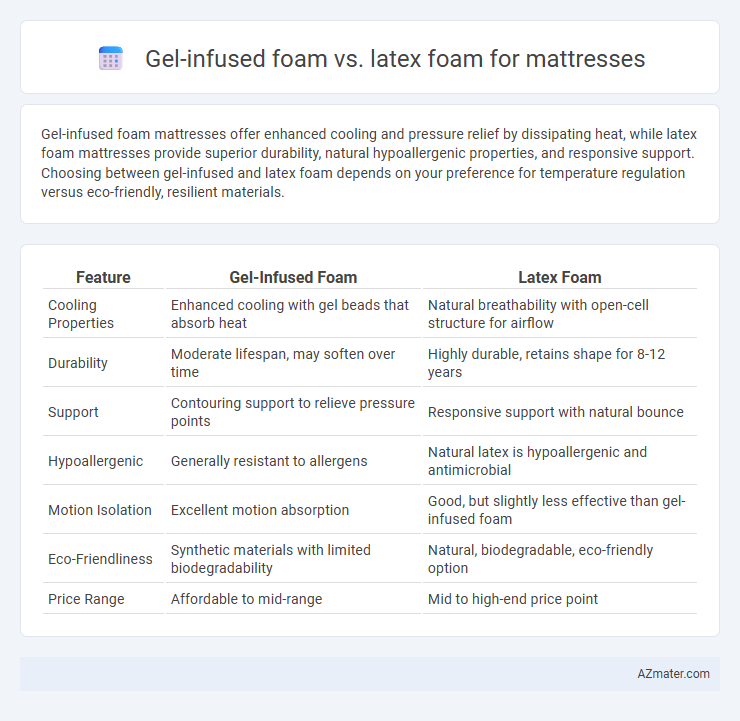Gel-infused foam mattresses offer enhanced cooling and pressure relief by dissipating heat, while latex foam mattresses provide superior durability, natural hypoallergenic properties, and responsive support. Choosing between gel-infused and latex foam depends on your preference for temperature regulation versus eco-friendly, resilient materials.
Table of Comparison
| Feature | Gel-Infused Foam | Latex Foam |
|---|---|---|
| Cooling Properties | Enhanced cooling with gel beads that absorb heat | Natural breathability with open-cell structure for airflow |
| Durability | Moderate lifespan, may soften over time | Highly durable, retains shape for 8-12 years |
| Support | Contouring support to relieve pressure points | Responsive support with natural bounce |
| Hypoallergenic | Generally resistant to allergens | Natural latex is hypoallergenic and antimicrobial |
| Motion Isolation | Excellent motion absorption | Good, but slightly less effective than gel-infused foam |
| Eco-Friendliness | Synthetic materials with limited biodegradability | Natural, biodegradable, eco-friendly option |
| Price Range | Affordable to mid-range | Mid to high-end price point |
Introduction to Gel-Infused Foam and Latex Foam
Gel-infused foam incorporates cooling gel beads within traditional memory foam, enhancing temperature regulation and providing pressure relief by conforming closely to the body's contours. Latex foam is derived from natural or synthetic rubber, offering resilient support, durability, and hypoallergenic properties with a buoyant feel. Both materials excel in comfort and support, yet gel-infused foam emphasizes cooling and contouring, while latex foam prioritizes responsiveness and eco-friendliness.
Key Differences Between Gel-Infused and Latex Foams
Gel-infused foam offers enhanced temperature regulation by incorporating cooling gel beads that dissipate heat, making it ideal for hot sleepers. Latex foam provides superior durability and natural resilience, often derived from organic sources, delivering consistent support and hypoallergenic properties. Unlike gel-infused foam's contouring comfort, latex foam offers a bouncier feel with faster response time, differentiating both in pressure relief and motion isolation capabilities.
Comfort and Support Comparison
Gel-infused foam mattresses provide enhanced temperature regulation by dispersing heat, ensuring a cooler sleep environment compared to traditional latex foam. Latex foam offers superior responsiveness and a buoyant support system, adapting quickly to body movement and promoting spinal alignment. Both materials provide pressure relief, but gel-infused foam excels in contouring while latex foam delivers durable and consistent support throughout the night.
Breathability and Temperature Regulation
Gel-infused foam mattresses offer enhanced breathability through their open-cell structure and cooling gel beads that efficiently dissipate heat, maintaining a cooler sleep surface. Latex foam provides natural breathability due to its inherent aerated structure and moisture-wicking properties, promoting consistent airflow and temperature regulation. Both materials excel in temperature control, with gel-infused foam focusing on active heat dispersion and latex foam leveraging its organic stretch and airflow capabilities.
Durability and Lifespan
Gel-infused foam mattresses typically offer moderate durability, with an average lifespan of 6 to 8 years, as the gel infusion helps regulate temperature but does not significantly enhance structural resilience. Latex foam mattresses, especially those made from natural latex, are renowned for superior durability and longevity, often lasting 10 to 15 years or more due to their high-density composition and natural resilience against sagging and wear. When prioritizing long-term investment, latex foam provides a more durable option compared to gel-infused foam, maintaining support and comfort over extended use.
Allergen Resistance and Hypoallergenic Properties
Gel-infused foam offers enhanced allergen resistance by incorporating cooling gel beads that inhibit dust mites and mold growth, making it a suitable option for allergy sufferers. Latex foam, derived from natural rubber, is inherently hypoallergenic and resistant to dust mites, mold, and mildew, promoting a healthier sleeping environment. Both materials provide strong allergen defense, but latex foam's natural antimicrobial qualities often make it the preferred choice for those with severe allergies or chemical sensitivities.
Environmental Impact of Both Foams
Gel-infused foam mattresses often contain synthetic materials derived from petrochemicals, leading to higher carbon emissions and longer decomposition times compared to natural alternatives. Latex foam mattresses, especially those made from natural latex, offer more eco-friendly benefits with biodegradable properties and sustainably harvested rubber tree sap. While synthetic latex variants may share some environmental drawbacks with gel-infused foams, natural latex significantly reduces chemical usage and landfill waste, making it a preferable choice for sustainability.
Price and Value for Money
Gel-infused foam mattresses typically offer a more affordable price point compared to latex foam, making them a popular choice for budget-conscious buyers seeking cooling properties and pressure relief. Latex foam mattresses, while generally higher in price, provide exceptional durability, natural hypoallergenic benefits, and consistent support, delivering superior value over time despite the initial investment. Evaluating long-term performance and comfort, latex foam often justifies its cost through enhanced lifespan and health advantages, whereas gel-infused foam suits those prioritizing immediate savings without sacrificing essential cooling features.
Suitability for Different Sleepers
Gel-infused foam mattresses excel at temperature regulation, making them ideal for hot sleepers who require consistent cooling throughout the night. Latex foam offers superior responsiveness and natural bounce, benefiting combination sleepers who frequently change positions. Side sleepers may prefer the contouring and pressure relief of gel-infused foam, while back and stomach sleepers often favor latex foam for its firmness and support.
Which Foam is Best for You?
Gel-infused foam offers enhanced cooling properties by dispersing body heat, making it ideal for hot sleepers, while latex foam provides superior durability and natural responsiveness with hypoallergenic benefits suited for allergy sufferers. Your choice depends on whether you prioritize temperature regulation and pressure relief or long-lasting support with eco-friendly materials. Considering personal sleep patterns, body weight, and sensitivity to heat will help determine the best foam type for a comfortable and restful mattress experience.

Infographic: Gel-infused foam vs Latex foam for Mattress
 azmater.com
azmater.com